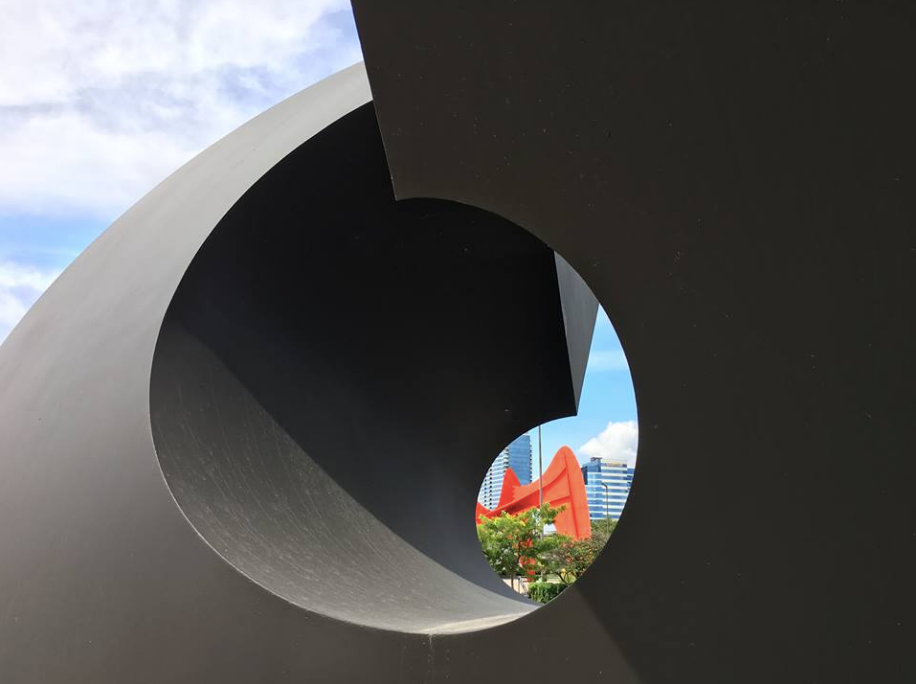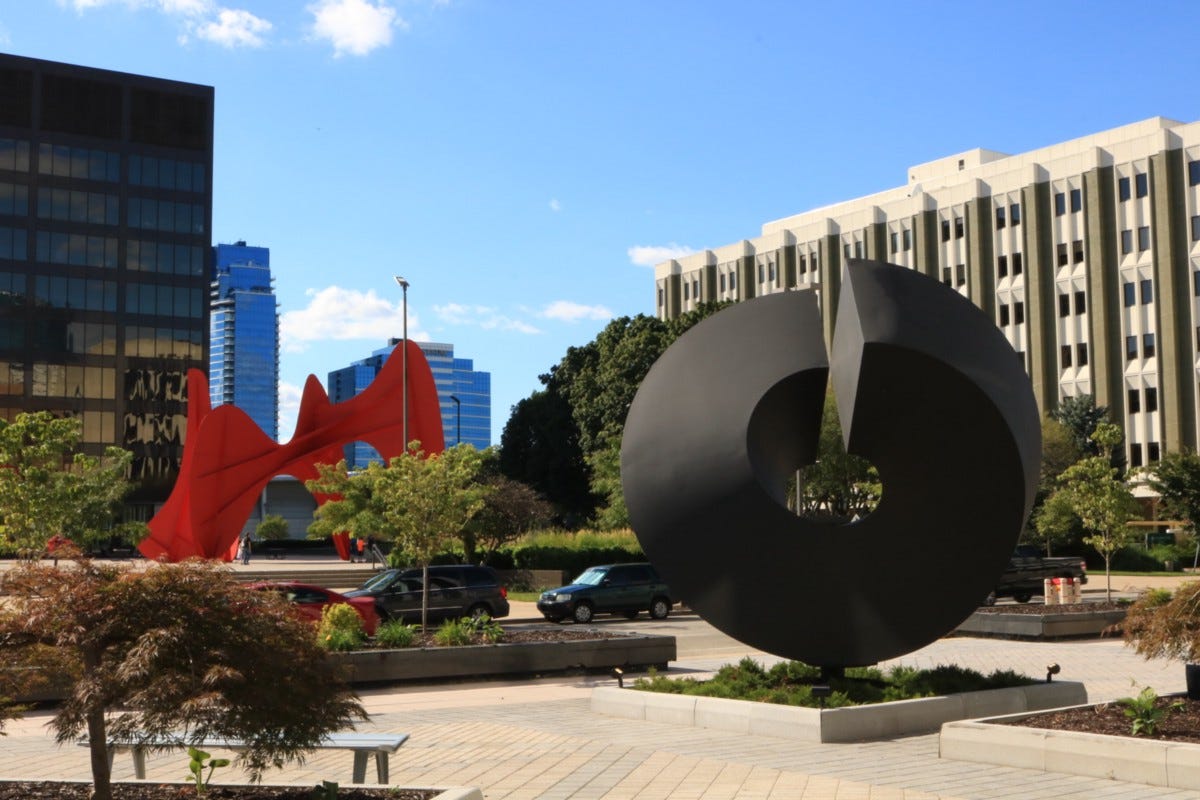Inspired: How culturedGR got its logo
We can’t decide if we’re more inspired by the sculpture itself–or the fearless women who brought it here.

You may have noticed that our logo looks a little bit familiar. Turn it on its side, remove the bright colors, and voila: you’ve got Clement Meadmore’s “Split Ring.” The work was part of a public art exhibition called “Sculpture Off the Pedestal” back in 1973. This exhibit was brought to Grand Rapids entirely by a committee of women, and almost entirely through the donation of time and resources throughout our community. These women, who in their day were told it wasn’t proper to have a job outside the home, went ahead and did great things anyway.
“They have made Grand Rapids a large tributary of the mainstream of the art world,” says an award given to the Women’s Committee of the Grand Rapids Art Museum in 1974. “For its dedicated hard work, outstanding achievement and for affecting the lives of all our citizens with new visual and emotional horizons, we are honored to express our gratitude to the Women’s Committee of the Grand Rapids Art Museum.” [Emphasis mine.]
Their work was highlighted in national publications like Art in America and Time Magazine. When these women brought challenging modern art to our city, the nation noticed. Not only did they bring impressive work to the city and garner the national attention from the arts community, but they worked tirelessly to make sure local citizens could access and appreciate what was, at the time and for some still is, challenging work to unpack: modern sculpture.
Gorgeous modern sculpture, like Clement Meadmore’s “Split Ring,” which just this summer returned to its original place downtown. Right across from “the Calder” in our city’s soon-t0-be-reimagined plaza, the return (from the Woodland Mall, no less) caught my eye from the beginning. Simple, powerful, creating a window into great work in front of it… so much of the sculpture itself made me want to honor it in our logo as we worked to turn cultured.GR from a long-standing pipe dream into reality.
But as I learned about the exhibit “Sculpture Off the Pedestal” in 1973 that brought it here, I became even more inspired by the women who worked to bring such important art to us.
Peggy Bransdorfer, now 85, chaired 50 volunteers in the Women’s Committee when “Sculpture Off the Pedestal” came to town. She says countless hours were spent giving tours to local citizens, helping them go from confused or disgusted to understanding and appreciative.
“When the Calder came, people were not crazy about the Calder, but we helped them to like [it],” she says of the education the Women’s Committee did just a few short years before when Alexander Calder’s “La Grande Vitesse” arrived in 1969. It was the first NEA-supported work in their Art in Public Places program, and considered quite avant garde. Bransdorfer recalls that by the time “Sculpture Off the Pedestal” came just four years later, people were praising “La Grande Vitesse” and sending letters to the editor at the Grand Rapids Press, forgetting their earlier concern and saying how much better the Calder was than this new exhibit.
“What a bunch of dunk and what a waste of money,” she remembers of early complaints. But, she says, just like for the Calder sculpture, they helped people understand the work and once again gained the public’s favor.
“It drew a lot of people downtown, and it drew a lot of talking about art,” she says. “By the end, the City Commission asked [us] to extend the exhibit significantly.”

And so, as we embark on this path for a new publication focusing solely on the visual and performing arts, we have big shoes to fill. We have inspiring women to model ourselves after. We hope you’ll join in conversations and get to know creators. We hope you’ll reconsider the joys of going to a symphony performance or watching an opera. We hope that immersing yourself in beauty, on a regular basis, becomes a part of your family’s favorite pastimes, like it is for ours. There are so many ways to access local arts and culture events, no matter what your budget is or how many kids you have in tow—and we have no intention of just showing off the big-ticket items.
The arts are for everyone. The arts keep us healthy. They bring us beauty. They challenge us to think. Or they give us a great big gorgeous reason not to think. Sometimes we need to just remember how beautiful moments of life can be so we can carry on another day, keeping the overwhelm, the cacophony of information that has become our modern existence, at bay.
But one more thing we must say: we can’t be healthy if all we do is say how wonderful everything is. Art criticism is an important element in any healthy arts community. It helps our creators learn what we see, and what we’re not yet seeing, as they seek to constantly improve their life’s work. It also, though, brings us all into the conversation, and teaches all of us how to engage in civil discourse in a safe space. Art criticism, in our view, is not just for the expert to proclaim and for the rest of the plebeians to listen. We need experts, of course. We need experts when our car breaks down and when our bodies fail us. We need experts to help us learn more about art as well. But we believe that art criticism is the starting point. Conversations about art are a community act, just as arts events are community events, activating public space and getting us all in a room together. Art criticism helps us think about art. It helps us talk about art. It challenges us to determine what we value, fosters healthy discourse, and keeps us learning. Art criticism is the starting point, so that we can all join in the conversation.
And so, we bring to you culturedGR. We’ll help you take advantage of what our local arts community is creating for us. We’ll provide resources for making the arts a more regular, valuable part of our our daily lives. I can’t help but think we’re a small part of the work already happening to continue on the rich history of Grand Rapids setting the pace for art appreciation nationwide.
Peggy Bransdorfer’s daughter Jill Bransdorfer Leona remembers those heydays of the Grand Rapids art scene well.
“I was in third grade when my mother co-chaired that exhibition. The sculptures included in ‘Sculpture Off the Pedestal’ — huge, lean, imposing and inspiring — speak to a legacy of vision shared by those hard-working women, who as volunteers did it for love, not money. It seems to me personally, those women, and the exhibition they conceived and worked hard to make happen , were ahead of their time, and on the right side of history,” she says. “Inspiring, what they achieved, together.”
Who will we inspire—what will we achieve next—together?